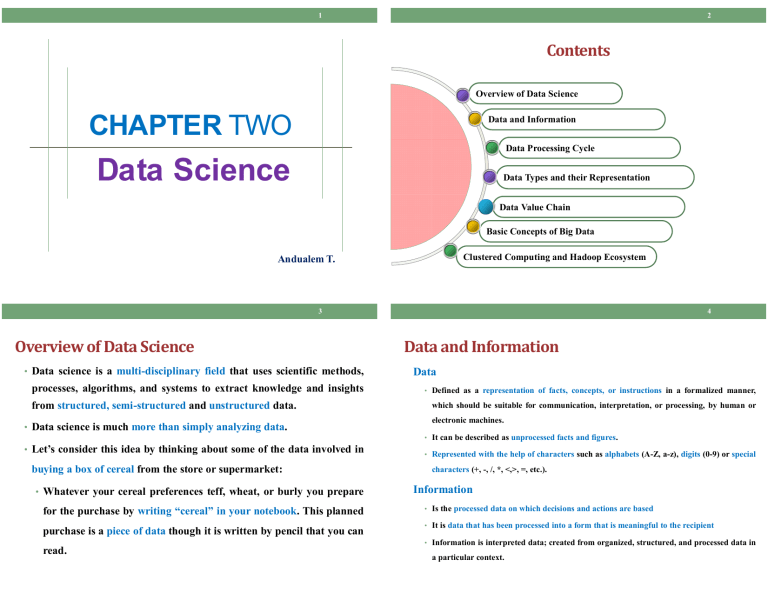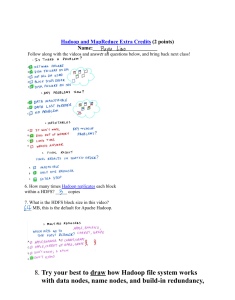
1 2 Contents Overview of Data Science CHAPTER TWO Data and Information Data Processing Cycle Data Science Data Types and their Representation Data Value Chain Basic Concepts of Big Data Clustered Computing and Hadoop Ecosystem Andualem T. 3 Overview of Data Science • Data science is a multi-disciplinary field that uses scientific methods, processes, algorithms, and systems to extract knowledge and insights from structured, semi-structured and unstructured data. • Data science is much more than simply analyzing data. • Let’s consider this idea by thinking about some of the data involved in buying a box of cereal from the store or supermarket: • Whatever your cereal preferences teff, wheat, or burly you prepare for the purchase by writing “cereal” in your notebook. This planned purchase is a piece of data though it is written by pencil that you can read. 4 Data and Information Data • Defined as a representation of facts, concepts, or instructions in a formalized manner, which should be suitable for communication, interpretation, or processing, by human or electronic machines. • It can be described as unprocessed facts and figures. • Represented with the help of characters such as alphabets (A-Z, a-z), digits (0-9) or special characters (+, -, /, *, <,>, =, etc.). Information • Is the processed data on which decisions and actions are based • It is data that has been processed into a form that is meaningful to the recipient • Information is interpreted data; created from organized, structured, and processed data in a particular context. 5 Data Processing Cycle 6 Data Processing Cycle • Data processing is the re-structuring or re-ordering of data by people or machines to increase their usefulness and add values for a particular • Input • In this step, the input data is prepared in some convenient form for processing. • The form will depend on the processing machine. purpose. • For example, when electronic computers are used, the input data can be recorded on any one • Data processing consists of the following basic steps - input, processing, of the several types of storage medium, such as hard disk, CD, flash disk and so on. • Processing and output. • In this step, the input data is changed to produce data in a more useful form. • These three steps constitute the data processing cycle • For example, interest can be calculated on deposit to a bank, or a summary of sales for the month can be calculated from the sales orders. • Output • At this stage, the result of the proceeding processing step is collected. • The particular form of the output data depends on the use of the data. • For example, output data may be payroll for employees. 7 Data Types and their Representation • Data types can be described from diverse perspectives. • In computer science and computer programming, for instance, a data type is simply an attribute of data that tells the compiler or interpreter how the programmer intends to use the data. 1. Data types from Computer programming perspective • Almost all programming languages explicitly include the notion of data type. • Common data types include • Integers(int)- is used to store whole numbers, mathematically known as integers • Booleans(bool)- is used to represent restricted to one of two values: true or false • Characters(char)- is used to store a single character • Floating-point numbers(float)- is used to store real numbers • Alphanumeric strings(string)- used to store a combination of characters and numbers 8 Data Types and their Representation 2. Data types from Data Analytics perspective • From a data analytics point of view, it is important to understand that there are three common types of data types or structures: A. Structured B. Semi-structured, and C. Unstructured data types • below describes the three types of data and metadata. 9 Structured Data 10 Semi-structured Data • Structured data is data that adheres to a pre-defined data model and is therefore straightforward to analyze. • Semi-structured data is a form of structured data that does not conform with the formal structure of data models associated with relational • Structured data conforms to a tabular format with a relationship between databases or other forms of data tables, but nonetheless, contains tags or other markers to separate semantic elements and enforce hierarchies of the different rows and columns. records and fields within the data. • Example: Excel files or SQL databases. • Each of these has structured rows and columns that can be sorted. • Therefore, it is also known as a self-describing structure. • Examples: JSON and XML are forms of semi-structured data. 11 Unstructured Data • Unstructured data is information that either does not have a predefined data model or is not organized in a pre-defined manner. • Unstructured information is typically text-heavy but may contain data such as dates, numbers, and facts as well. • This results in irregularities and ambiguities that make it difficult to 12 Metadata (Data about Data) • From a technical point of view, this is not a separate data structure, but it is one of the most important elements for Big Data analysis and big data solutions. • Metadata is data about data. • It provides additional information about a specific set of data. understand using traditional programs as compared to data stored in • metadata is frequently used by Big Data solutions for initial analysis. structured databases. • In a set of photographs, for example, metadata could describe when and • Example: Audio, video files or NoSQL databases. where the photos were taken. The metadata then provides fields for dates and locations which, by themselves, can be considered structured data. 13 Data Value Chain 14 Data Acquisition • The Data Value Chain is introduced to describe the information flow • It is the process of gathering, filtering, and cleaning data before it is put in within a big data system as a series of steps needed to generate value and a data warehouse or any other storage solution on which data analysis can useful insights from data. be carried out. • The Big Data Value Chain identifies the following key high-level activities: • Data acquisition is one of the major big data challenges in terms of infrastructure requirements. • The infrastructure required to support the acquisition of big data must deliver low, predictable latency in both capturing data and in executing queries; be able to handle very high transaction volumes, often in a distributed environment; and support flexible and dynamic data structures. 15 Data Analysis • It is concerned with making the raw data acquired amenable to use in decision-making as well as domain-specific usage. • Data analysis involves exploring, transforming, and modeling data with the goal of highlighting relevant data, synthesizing and extracting useful hidden information with high potential from a business point of view. • Related areas include data mining, business intelligence, and machine learning. 16 Data Curation • It is the active management of data over its life cycle to ensure it meets the necessary data quality requirements for its effective usage. • Data curation processes can be categorized into different activities such as content creation, selection, classification, transformation, validation, and preservation. • Data curation is performed by expert curators that are responsible for improving the accessibility and quality of data. • Data curators (also known as scientific curators or data annotators) hold the responsibility of ensuring that data are trustworthy, discoverable, accessible, reusable and fit their purpose. • A key trend for the duration of big data utilizes community and crowdsourcing approaches. 17 Data Storage 18 Data Usage • It is the persistence and management of data in a scalable way that satisfies the needs of applications that require fast access to the data. • It covers the data-driven business activities that need access to data, its analysis, and the tools needed to integrate the data • Relational Database Management Systems (RDBMS) have been the main, analysis within the business activity. and almost unique, a solution to the storage paradigm for nearly 40 years. • However, the ACID (Atomicity, Consistency, Isolation, and Durability) • Data usage in business decision-making can enhance properties that guarantee database transactions lack flexibility with regard to competitiveness through the reduction of costs, increased added schema changes and the performance and fault tolerance when data volumes value, or any other parameter that can be measured against and complexity grow, making them unsuitable for big data scenarios. existing performance criteria. • NoSQL technologies have been designed with the scalability goal in mind and present a wide range of solutions based on alternative data models. 19 Basic Concepts of Big Data 20 What is Big Data? • Big data is a blanket term for the non-traditional strategies and • Big data is the term for a collection of data sets so large and complex technologies needed to gather, organize, process, and gather that it becomes difficult to process using on-hand database insights from large datasets. management tools or traditional data processing applications. • While the problem of working with data that exceeds the computing power or storage of a single computer is not new, the pervasiveness, scale, and value of this type of computing have greatly expanded in recent years. • In this context, a “large dataset” means a dataset too large to reasonably process or store with traditional tooling or on a single computer. • This means that the common scale of big datasets is constantly shifting and may vary significantly from organization to organization. • Big data is characterized by 3V and more: Volume, Velocity, Variety and Veracity 21 What is Big Data? 22 Clustered Computing and Hadoop Ecosystem • Clustered Computing • Characteristics of Big Data • Because of the qualities of big data, individual computers are often • Volume: large amounts of data Zeta bytes/Massive datasets inadequate for handling the data at most stages. • Velocity: Data is live streaming or in motion • Variety: data comes in many different forms from diverse sources • Veracity: can we trust the data? How accurate is it? etc. • To better address the high storage and computational needs of big data, computer clusters are a better fit. • Big data clustering software combines the resources of many smaller machines, seeking to provide a number of benefits: • Resource Pooling • High Availability • Easy Scalability 23 Clustered Computing and Hadoop Ecosystem • Resource Pooling • Combining the available storage space to hold data is a clear benefit, but CPU and memory pooling are also extremely important. • Processing large datasets requires large amounts of all three of these resources. • High Availability • Clusters can provide varying levels of fault tolerance and availability guarantees to prevent hardware or software failures from affecting access to data and processing. • This becomes increasingly important as we continue to emphasize the importance of real-time analytics. • Easy Scalability • Clusters make it easy to scale horizontally by adding additional machines to the group. This means the system can react to changes in resource requirements without expanding the physical resources on a machine. 24 Clustered Computing and Hadoop Ecosystem • Using clusters requires a solution for managing cluster membership, coordinating resource sharing, and scheduling actual work on individual nodes. • Cluster membership and resource allocation can be handled by software like Hadoop’s YARN (which stands for Yet Another Resource Negotiator). • The assembled computing cluster often acts as a foundation that other software interfaces with to process the data. • The machines involved in the computing cluster are also typically involved with the management of a distributed storage system, which we will talk about when we discuss data persistence. 25 Clustered Computing and Hadoop Ecosystem • Hadoop and its Ecosystem 26 Hadoop and its Ecosystem • The four key characteristics of Hadoop are: • Hadoop is an open-source framework intended to make interaction with big data easier. • It is a framework that allows for the distributed processing of large datasets across clusters of computers using simple programming models. • Economical: Its systems are highly economical as ordinary computers can be used for data processing. • Reliable: It is reliable as it stores copies of the data on different • It is inspired by a technical document published by Google. machines and is resistant to hardware failure. • The four key characteristics of Hadoop are: • Scalable: It is easily scalable both, horizontally and vertically. A • Economical few extra nodes help in scaling up the framework • Reliable • Flexible: It is flexible and you can store as much structured and • Scalable unstructured data as you need to and decide to use them later. • Flexible 27 Hadoop and its Ecosystem • Hadoop has an ecosystem that has evolved from its four core components: data management, access, processing, and storage. • It is continuously growing to meet the needs of Big Data. • It comprises the following components and many others: • • • • • • • • • • HDFS: Hadoop Distributed File System YARN: Yet Another Resource Negotiator MapReduce: Programming based Data Processing Spark: In-Memory data processing PIG, HIVE: Query-based processing of data services HBase: NoSQL Database Mahout, Spark MLLib: Machine Learning algorithm libraries Solar, Lucene: Searching and Indexing Zookeeper: Managing cluster Oozie: Job Scheduling 28 Hadoop and its Ecosystem 29 Big Data Life Cycle with Hadoop 30 Big Data Life Cycle with Hadoop • Ingesting data into the system • Computing and analyzing data • The first stage of Big Data processing is Ingest. • The third stage is to Analyze. • The data is ingested or transferred to Hadoop from various sources • Here, the data is analyzed by processing frameworks such as Pig, such as relational databases, systems, or local files. • Sqoop transfers data from RDBMS to HDFS, whereas Flume transfers event data. Hive, and Impala. • Pig converts the data using a map and reduce and then analyzes it. • Hive is also based on the map and reduce programming and is most suitable for structured data. • Processing the data in storage • Visualizing the results • The second stage is Processing. • In this stage, the data is stored and processed. • The data is stored in the distributed file system, HDFS, and the NoSQL distributed data, HBase. • Spark and MapReduce perform data processing. • The fourth stage is Access, which is performed by tools such as Hue and Cloudera Search. • In this stage, the analyzed data can be accessed by users. 31 ? END OF CHAPTER TWO Next: Chapter Three: Artificial Intelligence




